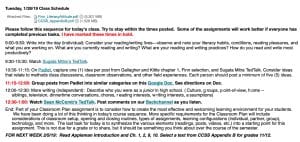Filling a College Need
When I signed on to teach the Educational Technology course for one semester, I was ready to innovate the curriculum. I had just spent the summer with team members working on accreditation reports and knew that updating the ISTE standards and assignments in that course would make a difference in the way we and the students approached technology. Having always enjoyed exploring and implementing new technology tools throughout my teaching career, I felt comfortable modifying assignments, creating rubrics, and updating syllabus language.
Then it was class time.
Educational Technology Course
Students in the Educational Technology course came from a myriad of programs — early childhood, elementary and middle grades, high school — and a few not in the college of education at all. With that in mind, I decided to emphasize that in this class we wear two hats: (1) future teachers who must gather technology tools and resources for future students and (2) future professionals in the field who need to collaborate with other teaching professionals.
In most class meetings we got our hands dirty with a variety of resources. We used them ourselves, evaluated their effectiveness, and, as small groups or individually, presented them to the class. On the last day, they presented their final assignment, a digital story of their technology journey. Students in both sections of the course shared their growth and Aha moments from the class activities, content exploration, and discussion with others who were on the same journey.
Student Evaluations of Instruction (SEI)
At the end of each semester, as our university courses must, student evaluations of instruction (SEI) surveys were distributed. My experience with abysmal response rates, not unlike this study reports, prompted me to offer a few bonus points if the response rate reached 80%. I was pleased with the resulting 88% response rate of 66 students – almost as many as I had taught in total during my previous four semesters. Though opinion pieces, professor appeals, and university decisions posit varied views on the usefulness of SEIs, I appreciated the opportunity to see these students’ perspectives.
Thinking Positive
Filling in for the Educational Technology course at a critical time of updating lessons and assignments to new standards left me frazzled. So when I viewed Educational Technology section one’s responses, I felt that the time invested in developing new assignments and rubrics was well worth it. The comments included the following:
“I loved doing the tool curations and finding out new tools which I could find for my classroom in the near upcoming future. I wish I could take her again. I also loved doing the small lesson plans which I had to implement tools like that. I really enjoyed learning about different ways to use apps and see how a lesson plan fits with the technology.”
“The instructor was great. I learned about new resources to implement into my future classroom’s curriculum.”
“She really cares and is there to help with any questions the class had for working with the pieces of technology. I really enjoyed her course!!!!”
“She is very well informed in the field of educational technology and seemed like she was comfortable with the tools presented in class.”
“Honestly, Dr. V was amazing. She did such a great job teaching the course. She opened my eyes to a lot of new things. I just wish this course was a hybrid because there was a lot of workshop time that could have been done outside of the class where she seemed like she didn’t know what to do. We were working and didn’t need much help. The questions we had could have been answered via email. I think she would agree.”
I do, indeed, agree with the last statement about hybrid or online instruction. The class included workshop time to ensure student-to-student and teacher-student assistance. We could have had these productive work sessions online.
Checking My Ego
Unfortunately, the only way I can describe the responses of section two of this same course is “brutal.” Students complained about the content, stated that the course was only useful for other teacher preparation programs, and criticized the communication:
“I sat through this class all semester but learned nothing. I feel like this class was a waste of my time and money.”
“This course had nothing to do with what we were supposed to be learning and it was very frustrating. Instead of learning about tools to help us as teachers, we were learning tools that students could use in the classroom. I didn’t feel like I was learning anything valuable in the class so I stopped attending. It’s frustrating paying for a course you won’t get anything out of. I think clearer goals and objectives would have been better.”
“This class needs to be a hybrid class and should not be required for Early Childhood majors. There was hardly any useful information for Early Childhood majors to actually use in our classrooms and I am severely disappointed.”
Responding to such different student perspectives in my tenure portfolio SEI reflection is daunting and nerve-racking. I sought out advice from my division chair who suggested “stymied” for some language to use.
Digging Deeper for Meaning
In digging deeper to find reasons for these contradictory perspectives, I can point to several factors that may have been the difference.
Classroom
As Samantha Thomsen writes, classroom design influences educational outcomes.
In section one, the laptops were arranged on six-person tables. Students routinely sat in certain seats, often next to an acquaintance or friend, creating natural proximity for group work. I walked around the room during workshop time and was able to pull up a seat next to students when they asked questions or needed guidance.
In section two, the desktop computers were arranged in five rows of six seats on both the left and right side of the room with a wide aisle in the center. Students sat sometimes two or three in a row, but there were enough seats that some rows consistently only had one student. I tried to circulate through the rows during workshop time, but even if I sucked everything in really tightly, I could not get to some areas. During group workshop time, students awkwardly moved to other areas with their personal laptops in tow if they had them.
Class time
Many students worked full– or part-time jobs, limiting their choice of class times.
Section one was taught on Mondays at 1:30, drawing in primarily full-time students with part-time jobs. My day started around 10:00 with office hours and planning.
Section two was taught on Tuesdays at 4:30 and was filled with students who started their days very early with full-time jobs. My day started at 8:30 teaching a methods course from 9:00-1:00 off-campus. Then, between 2:00-4:00 I either planned or more often attended meetings.
Majors
The SEIs overrepresented some groups and underrepresented others in both sections.
Section one student majors had the following breakdown:
- Early Childhood – 11
- Elementary Education – 4
- Secondary Education – 1
- Interdisciplinary Studies – 1
Section two student majors were the following:
- Business Administration – 1
- Early Childhood – 6
- Elementary Education – 9
- Content area major (math, English) – 2
- Informational Technology – 1
Interestingly (and too late), I just discovered this site that outlines the Guiding Principles for Use of Technology with Early Learners. The overwhelmingly positive statements in section one do not sync with the complaints from early childhood majors in section two. Section one’s early childhood majors had larger peer support for applying technology standards to younger children. The same could be said for elementary education majors in section two.
Technical
The technical aspects such as classroom machine capabilities, Blackboard assignments, and Blackboard announcements seem to be foundational.
The laptop webcams in the section one classroom allowed students to capture themselves in a picture for their personal introductions on Padlet, unlike most of the personal introductions in section two that used clipart.
Usually navigating Blackboard is fine, but one of the assignments I tried to post and link for section two did not show up where I thought it should. I posted it again and caused a ruckus. This problem was unique to section two; whereas, most times the first section taught during the week would be where kinks and ironing happen.
For one class meeting, section two was supposed to attend a teacher panel for the first hour or so of class and write a blog post about it. Very few students showed up and then some of them were waiting in the classroom unaware. The course announcement system seemed ineffective on this and other occasions.
Next Steps
We hired an outstanding new faculty member to pick up these course sections and other technology responsibilities in the college. Frankly, I’m relieved. But as a highly-reflective teacher and lifelong learner, I cannot ignore some important findings from this analysis:
- Classroom setup matters. Planning lessons needs to include a vision of the space in which the instruction will happen. This setup includes group dynamics, as well. Intentional grouping of content areas and majors makes a difference.
- Clarity is essential. Nothing can be spelled out too much, said too often, or modeled enough.
- Concentrate on the present. This means close off everything that keeps me from being mentally ready for the upcoming class, including meetings too near class time.
I’m interested in how you reflect on class evaluations or use student perspectives to inform instruction.







